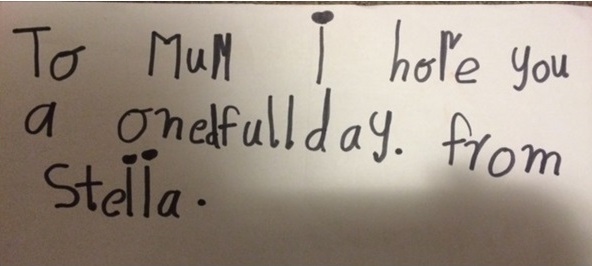BLOG 2 - A letter from my daughter.

My daughter wrote me this beautiful letter in Grade 2 saying “I hope you have a onedfull *wonderful* day”. She had made my heart sing with her heart felt sentiments, but also a small part of me had that parental concern that her spelling of ‘wonderful’, while so close phonetically, was so terribly inventive and incorrect. As a younger child I would have found this note very endearing but as a developing writer should I be concerned? I accepted the note with the intent it was given but I desperately wanted to correct it…maybe that’s the teacher coming out in me!
I am fully aware of the stages of learning to spell. I’ve seen children start to spell by using strings of random letters to represent a word. As their knowledge of phonic/letter relationship grows, they can identify some sounds in words. They then learn the importance of the vowel sound in words. This knowledge alongside their learning of sight words and their visual memory, start early spellers well on their way. They learn to spell basic words successfully.
But by Grade 1 and 2 students’ vocabulary begins to grow and they are reading and writing more purposefully. This is where the spelling divide begins. Children who nailed basic words with their phonics knowledge and memory now need to be able to integrate many more complex skills such as:
vowel discrimination – short and long vowel combinations
morphology – identifying the base word/ending relationship
etymology – the roots and origins of the word
orthography – are you using the correct spelling patterns and language conventions
In the example “onedfull” these things had not been considered. Good spellers know that the word ‘wonderful’ is derived from the word ‘wonder’ (etymology). We also know that ‘ful’ is an ending to the base word ‘wonder’ (morphology) and is different from the word ‘full’. We also know that each syllable in a word needs a vowel sound (orthography), and that ‘d’ would not represent the ‘der’ syllable (vowel discrimination). So many skills to integrate. So many skills I would not have known about or understood how to teach until I started using the DIPL program.
I kept the letter for the ‘cute’ factor (it still makes my heart sing), and when I glance at it from my office desk it is a wonderful reminder of the importance difference the DIPL program is making in helping children to understand language.
BLOG 1 - My journey in teaching spelling….
I recently read an article by Misty Adonoiu, from the University of Canberra, entitled “Why some kids can’t spell and why spelling tests won’t help” and one particular quote really resonated with me, “Spelling remains one of the most relentlessly tested of all the literacy skills, but it is the least taught”.
I reflected on my own teaching practice around spelling and knew that, in the past, I had been guilty of just this…of supplying endless graded spelling lists, relentlessly testing every Friday and earnestly recording spelling test scores. We would then spend time doing rather pointless activities such as ‘look, say, cover, write check’ which do not actually give students any spelling strategy. I did not have the knowledge, confidence or resources to teach spelling differently.
I think that the huge pedagogical shift I made in the way I taught of maths, which I attributed to the work of Michael Ymer, was the impetus for my spelling journey. Teaching maths had evolved from being very one dimensional, solitary work and an assessment driven subject to being more inquiry based, problem solving approach, where collaboration was valued. I often wondered if the same approach could possibly by applied to the teaching of spelling?
Like all new skills, the teacher needs the knowledge, confidence and the correct resources to facilitate change. The DIPL program provided me with specialist knowledge and confidence, as well as providing the correct examples and resources to allow me to help children to make spelling discoveries. Instead of learning lists, children could learn to apply spelling rules and articulate their choices, instead of working individually, students could support each other in their guided lessons, and instead of memorising words students could investigate patterns of language and form conclusions. My teaching was much more purposeful and my assessment was much more diagnostic. I no longer looked at the spelling score of each student but used spelling choices made to identify any issues and inform my teaching. DIPL was the tool that helped me make that shift in my teaching approach and I am thankful for the way it has helped me grow as a teacher, and in turn, benefited my students.